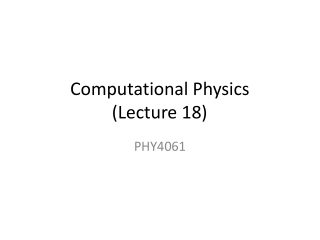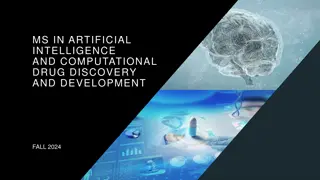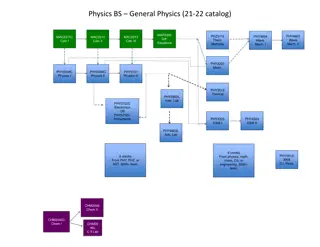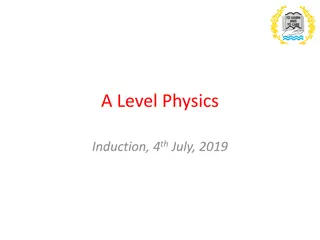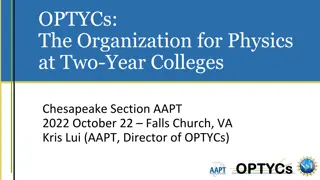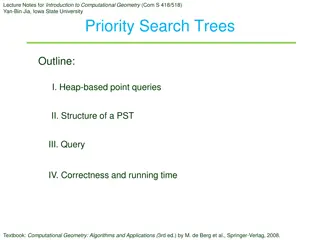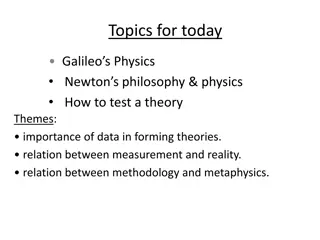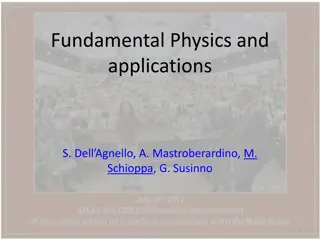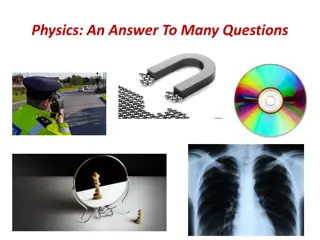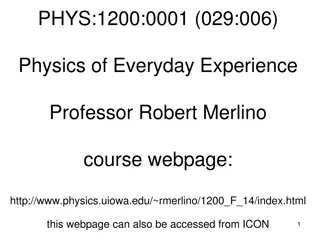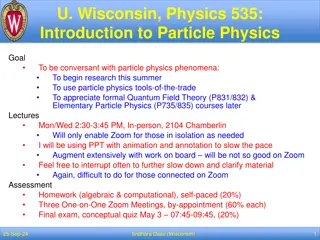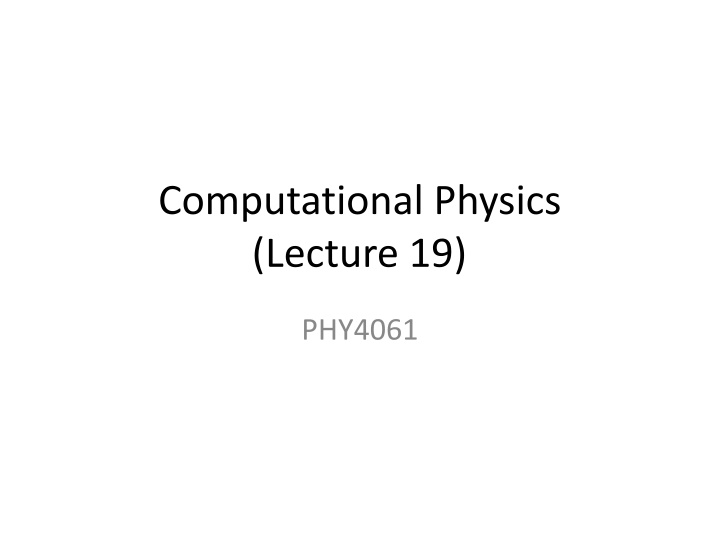
Unveiling the Power of Deep Learning in Computational Physics
Exploring the evolution of neural networks in computational physics, from early struggles with training deep networks to breakthroughs in techniques enabling the training of much deeper networks. Deep neural networks have revolutionized problem-solving by efficiently breaking down complex questions into simpler components and building hierarchies of abstract concepts. These advancements parallel the modular design principles of conventional programming, highlighting the importance of abstraction in neural networks. The emergence of deep neural networks has significantly improved classification accuracy, outperforming shallow networks on various tasks.
Download Presentation

Please find below an Image/Link to download the presentation.
The content on the website is provided AS IS for your information and personal use only. It may not be sold, licensed, or shared on other websites without obtaining consent from the author. If you encounter any issues during the download, it is possible that the publisher has removed the file from their server.
You are allowed to download the files provided on this website for personal or commercial use, subject to the condition that they are used lawfully. All files are the property of their respective owners.
The content on the website is provided AS IS for your information and personal use only. It may not be sold, licensed, or shared on other websites without obtaining consent from the author.
E N D
Presentation Transcript
Computational Physics (Lecture 19) PHY4061
The end result is a network which breaks down a very complicated question - does this image show a face or not - into very simple questions answerable at the level of single pixels. It does this through a series of many layers, with early layers answering very simple and specific questions about the input image, and later layers building up a hierarchy of ever more complex and abstract concepts. Networks with this kind of many-layer structure - two or more hidden layers - are called deep neural networks.
Researchers in the 1980s and 1990s tried using stochastic gradient descent and backpropagation to train deep networks. Unfortunately, except for a few special architectures, they didn't have much luck. The networks would learn, but very slowly, and in practice often too slowly to be useful.
Since 2006, a set of techniques has been developed that enable learning in deep neural nets. based on stochastic gradient descent and backpropagation, but also introduce new ideas. These techniques have enabled much deeper (and larger) networks to be trained - people now routinely train networks with 5 to 10 hidden layers. And, it turns out that these perform far better on many problems than shallow neural networks, i.e., networks with just a single hidden layer. The reason, of course, is the ability of deep nets to build up a complex hierarchy of concepts.
It's a bit like the way conventional programming languages use modular design and ideas about abstraction to enable the creation of complex computer programs. Comparing a deep network to a shallow network is a bit like comparing a programming language with the ability to make function calls to a stripped down language with no ability to make such calls. Abstraction takes a different form in neural networks than it does in conventional programming, but it's just as important.
Deep learning With the deep learning network, the improved system will classify 9,967/10000 correctly. Note that the correct classification is in the top right; our program's classification is in the bottom right:
Strange to use networks with fully-connected layers to classify images. Such a network architecture does not take into account the spatial structure of the images. Treats input pixels which are far apart and close together on exactly the same footing. Can we use an architecture which tries to take advantage of the spatial structure?
The origins of convolutional neural networks in 1970s. The seminal paper establishing the modern subject of convolutional networks was a 1998 paper, "Gradient-based learning applied to document recognition", by Yann LeCun, L on Bottou, Yoshua Bengio, and Patrick Haffner.
Convolutional neural networks use three basic ideas: local receptive fields, shared weights, and pooling.
Local receptive fields: In the fully-connected layers, the inputs were depicted as a vertical line of neurons. In a convolutional net, it'll help to think instead of the inputs as a 28 28 square of neurons, whose values correspond to the 28 28 pixel intensities we're using as inputs:
As per usual, we'll connect the input pixels to a layer of hidden neurons. But we won't connect every input pixel to every hidden neuron. Instead, we only make connections in small, localized regions of the input image. This is a local approximation.
To be more precise, each neuron in the first hidden layer will be connected to a small region of the input neurons, say, for example, a 5 5 region, corresponding to 25 input pixels. So, for a particular hidden neuron, we might have connections that look like this:
That region in the input image is called the local receptive field for the hidden neuron. It's a little window on the input pixels. Each connection learns a weight. And the hidden neuron learns an overall bias as well. You can think of that particular hidden neuron as learning to analyze its particular local receptive field.
We then slide the local receptive field across the entire input image. For each local receptive field, there is a different hidden neuron in the first hidden layer.
Whats the size of the first hidden layer? In fact, sometimes a different stride length is used.
Shared weights and biases use the same weights and bias for each of the 24 24 hidden neurons. for the j,kth hidden neuron, the output is: is the neural activation function. b is the shared value for the bias. wl,mis a 5 5 array of shared weights. And ax,y to denote the input activation at position x,y.
All the neurons in the first hidden layer detect exactly the same feature feature detected by a hidden neuron as the kind of input pattern that will cause the neuron to activate: it might be an edge in the image, for instance, or maybe some other type of shape. To see why this makes sense, suppose the weights and bias are such that the hidden neuron can pick out, say, a vertical edge in a particular local receptive field.
That ability: likely to be useful at other places in the image. Useful to apply the same feature detector everywhere in the image. Slightly more abstract terms: convolutional networks are well adapted to the translation invariance of images: move a picture of a cat (say) a little ways, and it's still an image of a cat So MNIST has less translation invariance (why?) than images found "in the wild", so to speak. Still, features like edges and corners are likely to be useful across much of the input space.
map from the input layer to the hidden layer a feature map. weights defining the feature map the shared weights. Bias defining the feature map in this way the shared bias. The shared weights and bias are often said to define a kernel or filter.
To do image recognition we'll need more than one feature map. And so a complete convolutional layer consists of several different feature maps
Each feature map is defined by a set of 5 5 shared weights, and a single shared bias. The result is that the network can detect 3 different kinds of features, with each feature being detectable across the entire image.
The 20 images correspond to 20 different feature maps (or filters, or kernels). Each map is represented as a 5 5 block image, corresponding to the 5 5 weights in the local receptive field. Whiter blocks mean a smaller (typically, more negative) weight, so the feature map responds less to corresponding input pixels. Darker blocks mean a larger weight, so the feature map responds more to the corresponding input pixels. Very roughly speaking, the images above show the type of features the convolutional layer responds to.
spatial structure here beyond what we'd expect at random: many of the features have clear sub-regions of light and dark. That shows our network really is learning things related to the spatial structure. It's difficult to see what these feature detectors are learning.
A lot of work on better understanding the features learnt by convolutional networks. a paper: Visualizing and Understanding Convolutional Networks by Matthew Zeiler and Rob Fergus (2013).
A big advantage of sharing weights and biases is that it greatly reduces the number of parameters involved in a convolutional network.
Pooling layers In addition to the convolutional layers just described, convolutional neural networks also contain pooling layers. Pooling layers are usually used immediately after convolutional layers. What the pooling layers do is simplify the information in the output from the convolutional layer.
pooling layer takes each feature map output from the convolutional layer and prepares a condensed feature map. For instance, each unit in the pooling layer may summarize a region of (say) 2 2 neurons in the previous layer. As a concrete example, one common procedure for pooling is known as max-pooling. In max-pooling, a pooling unit simply outputs the maximum activation in the 2 2 input region, as illustrated in the following diagram:
max-pooling as a way for the network to ask whether a given feature is found anywhere in a region of the image. It then throws away the exact positional information. The intuition is that once a feature has been found, its exact location isn't as important as its rough location relative to other features. A big benefit is that there are many fewer pooled features, and so this helps reduce the number of parameters needed in later layers.
Another common approach is known as L2 pooling. Take the square root of the sum of the squares of the activations in the 2 2 region. While the details are different, the intuition is similar to max-pooling: L2 pooling is a way of condensing information from the convolutional layer.
Using an ensemble of networks: An easy way to improve performance still further is to create several neural networks, and then get them to vote to determine the best classification. Suppose, for example, that we trained 5 different neural networks using the prescription above, with each achieving accuracies near to 99.6 percent. Even though the networks would all have similar accuracies, they might well make different errors, due to the different random initializations. It's plausible that taking a vote amongst our 5 networks might yield a classification better than any individual network.
Will neural networks and deep learning soon lead to artificial intelligence? Conway's law: Any organization that designs a system... will inevitably produce a design whose structure is a copy of the organization's communication structure.
So, for example, Conway's law suggests that the design of a Boeing 747 aircraft will mirror the extended organizational structure of Boeing and its contractors at the time the 747 was designed.
This is a common pattern The fields start out monolithic, with just a few deep ideas. Early experts can master all those ideas. But as time passes that monolithic character changes. We discover many deep new ideas, too many for any one person to really master. As a result, the social structure of the field re- organizes and divides around those ideas.
Instead of a monolith, we have fields within fields within fields, a complex, recursive, self-referential social structure, whose organization mirrors the connections between our deepest insights. And so the structure of our knowledge shapes the social organization of science. But that social shape in turn constrains and helps determine what we can discover. This is the scientific analogue of Conway's law.
how powerful a set of ideas are associated to deep learning, according to this metric of social complexity? How powerful a theory will we need, in order to be able to build a general artificial intelligence?
according to the metric of social complexity, deep learning is, if you'll forgive the play on words, still a rather shallow field. It's still possible for one person to master most of the deepest ideas in the field.
It's going to take many, many deep ideas to build an AI. And so Conway's law suggests that to get to such a point we will necessarily see the emergence of many interrelating disciplines, with a complex and surprising structure mirroring the structure in our deepest insights.

